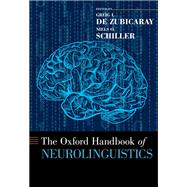- ISBN: 9780190672027 | 0190672021
- Cover: Hardcover
- Copyright: 4/1/2019
Neurolinguistics is a young and highly interdisciplinary field, with influences from psycholinguistics, psychology, aphasiology, and (cognitive) neuroscience, as well as other fields. Neurolinguistics, like psycholinguistics, covers aspects of language processing; but unlike psycholinguistics, it draws on data from patients with damage to language processing capacities, or the use of modern neuroimaging technologies such as fMRI, TMS, or both. The burgeoning interest in neurolinguistics reflects that an understanding of the neural bases of this data can inform more biologically plausible models of the human capacity for language.
The Oxford Handbook of Neurolinguistics provides concise overviews of this rapidly-growing field, and engages a broad audience with an interest in the neurobiology of language. The chapters do not attempt to provide exhaustive coverage, but rather present discussions of prominent questions posed by given topics. The volume opens with essential methodological chapters: Section I, Methods, covers the key techniques and technologies used to study the neurobiology of language today, with chapters structured along the basic divisions of the field. Section II addresses the neurobiology of language acquisition during healthy development and in response to challenges presented by congenital and acquired conditions. Section III covers the many facets of our articulate brain, or speech-language pathology, and the capacity for language production-written, spoken, and signed. Questions regarding how the brain comprehends meaning, including emotions at word and discourse levels, are addressed in Section IV. Finally, Section V reaches into broader territory, characterizing and contextualizing the neurobiology of language with respect to more fundamental neuroanatomical mechanisms and general cognitive domains.
The Oxford Handbook of Neurolinguistics provides concise overviews of this rapidly-growing field, and engages a broad audience with an interest in the neurobiology of language. The chapters do not attempt to provide exhaustive coverage, but rather present discussions of prominent questions posed by given topics. The volume opens with essential methodological chapters: Section I, Methods, covers the key techniques and technologies used to study the neurobiology of language today, with chapters structured along the basic divisions of the field. Section II addresses the neurobiology of language acquisition during healthy development and in response to challenges presented by congenital and acquired conditions. Section III covers the many facets of our articulate brain, or speech-language pathology, and the capacity for language production-written, spoken, and signed. Questions regarding how the brain comprehends meaning, including emotions at word and discourse levels, are addressed in Section IV. Finally, Section V reaches into broader territory, characterizing and contextualizing the neurobiology of language with respect to more fundamental neuroanatomical mechanisms and general cognitive domains.







